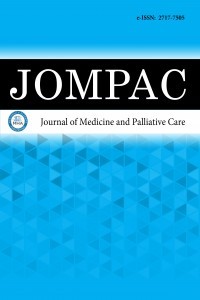Hepatosteatoz literatürün bütünsel analizi: 1980 ve 2019 arasındaki küresel hepatosteatoz yayınlarının scientometrik çalışması
Hepatosteatozis, bütünsel analiz, metabolik bozukluklar, scientometrik
Holistic analysis of hepatosteatosis literature: a scientometric study of global hepatosteatosis publications between 1980 and 2019
Hepatosteatosis, holistic analisis, metabolic disorders, scientometric,
___
- Wei S, Liu S, Su X, et al. Spontaneous development of hepatosteatosis in perilipin-1 null mice with adipose tissue dysfunction. Biochim Biophys Acta Mol Cell Biol Lipids 2018; 1863: 212-8.
- Obika M, Noguchi H. Diagnosis and evaluation of nonalcoholic fatty liver disease. Exp Diabetes Res 2012; 2012: 145754.
- Garg A. Adipose tissue dysfunction in obesity and lipodystrophy. Clin Cornerstone 2006; 8: 7-13.
- Liaqat M, Fatima M, Malik SS, Gillani SA, Manzoor I. Ultrasonographic features associated with diffuse hepatosteatosis among diabetic obese and normal body mass index patients. J Med Ultrasound 2020; 28: 235-8.
- Matteoni CA, Younossi ZM, Gramlich T, Boparai N, Liu YC, McCullough AJ. Nonalcoholic fatty liver disease: A spectrum of clinical and pathological severity. Gastroenterology 1999; 116: 1413-9.
- Bhatt HB, Smith RJ. Fatty liver disease in diabetes mellitus. Hepatobiliary Surg Nutr 2015; 4: 101–8.
- Rhee EJ. Nonalcoholic fatty liver disease and diabetes: An epidemiological perspective. Endocrinol Metab (Seoul) 2019; 34: 226-33.
- Chalasani N, Younossi Z, Lavine JE, et al. The diagnosis and management of non-alcoholic fatty liver disease: practice guideline by the American Gastroenterological Association, American Association for the Study of Liver Diseases, and American College of Gastroenterology. Gastroenterology 2012; 142: 1592–609.
- Das K, Das K, Mukherjee PS, et al. Nonobese population in a developing country has a high prevalence of nonalcoholic fatty liver and significant liver disease. Hepatology 2010; 51: 1593–02.
- Patton HM, Lavine JE. Focal fatty liver: More than just a radiographic curiosity? Gastroenterol Hepatol (N Y) 2007; 3: 199–200.
- World Health Organization. Global health sector strategy on viral hepatitis, 2016–2021. Geneva: 2016. Available at: http: //apps.who.int/iris/bitstream/10665/246177/1/WHO-HIV2016.06-eng.pdf?ua=1
- Şenel E. The last three decades of contact dermatitis: A bibliometric analysis of global publications on contact dermatitis. J Dermatol Nurses Assoc 2020; 12: 223-31.
- GunnMap. GunnMap 2 [www Document]. URL http: //lert.co.nz/map/ [accessed on 10 January 2020].
- Vosviewer. VOSviewer - Visualizing scientific landscapes. URL https: //www.vosviewer.com/ [accessed on 10 January 2020].
- Chalasani N, Younossi Z, Lavine JE, et al. The diagnosis and management of non-alcoholic fatty liver disease: Practice Guideline by the American Association for the Study of Liver Diseases, American College of Gastroenterology, and the American Gastroenterological Association. Hepatology 2012; 55: 2005-23.
- Trifan A, Stanciu C, Jurcău M, Zenovia S, Frunzuc G, Timofte D. Nonalcoholic steatohepatitis: A scientometric analysis of publications during 1980-2018. Medicine (Baltimore) 2019; 98: e18221.
- Bhupathiraju SN, Hu FB. Epidemiology of obesity and diabetes and their cardiovascular complications. Circ Res 2016; 118: 1723-35.
- Arroyo-Johnson C, Mincey KD. Obesity epidemiology worldwide. Gastroenterol Clin North Am 2016; 45: 571-9.
- Başlangıç: 2020
- Yayıncı: MediHealth Academy Yayıncılık
Mehmet BÜYÜKŞİRECİ, Ayşe Gülşen DOĞAN, Dilek EKER BÜYÜKŞİRECİ, Aynure ÖZTEKİN
Trombositten zengin fibrin ve diş hekimliğinde kullanımı
Sarah KHALED, Ebru OLGUN, Meltem HENDEK
Diyabetik maküla ödeminde arka vitreus dekolmanının rolü
Ayşe TÜFEKÇİ BALIKÇI, Nurten UNLU, Sunay DUMAN
Kronik pelvik ağrılı hastalarda laparoskopi sonuçlarının değerlendirilmesi
Asena AYAR MADENLİ, Halime ÇALI ÖZTÜRK
Selma SEZEN, Fatma YESİLYURT, Mustafa ÖZKARACA, Cemil BAYRAM, Burak ALAYLAR, Medine GÜLLÜCE, Ahmet HACIMÜFTÜOĞLU
Pınar Yeşim AKYOL, Hüseyin ACAR, Rezan KARAALİ, Ejder Saylav BORA, Fatih TOPAL
Pediatrik palyatif bakımda yaşam sonu bakım kavramı
Şanlıay ŞAHİN, Fatma Zehra ÖZTEK ÇELEBİ, Ganime AYAR
İmmünglobülin G4 ilişkili hastalıkta nüksü etkileyen faktörler: retrospektif bir analiz
Müge AYDIN TUFAN, Derya KAŞKARİ
Nadir görülen nutcracker sendromunun yirmi yıllık analizi
Burak DEMİRCİ, Çilem ÇALTILI, Mehmet Oktay ALKAN, İsa BAŞPINAR, Burak AKIN, Abuzer COŞKUN
Pediatrik palyatif bakımda verilen hizmet kalitesini belirleyen faktörler
